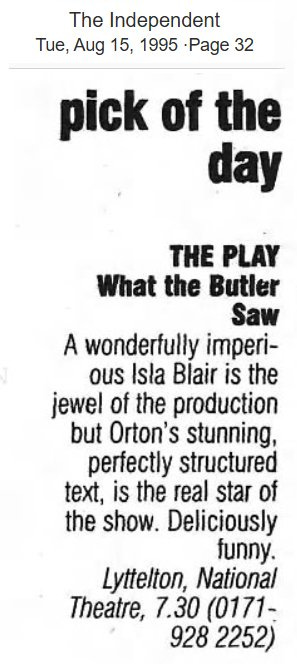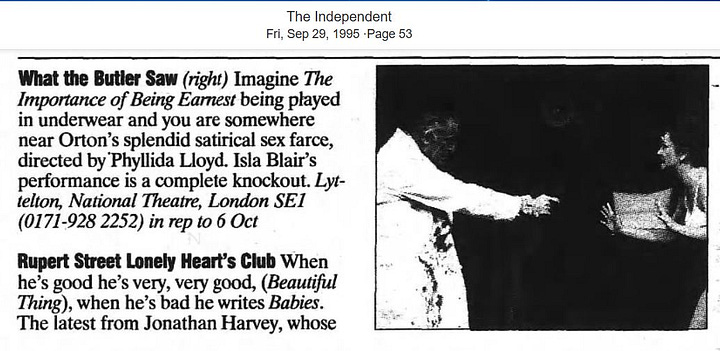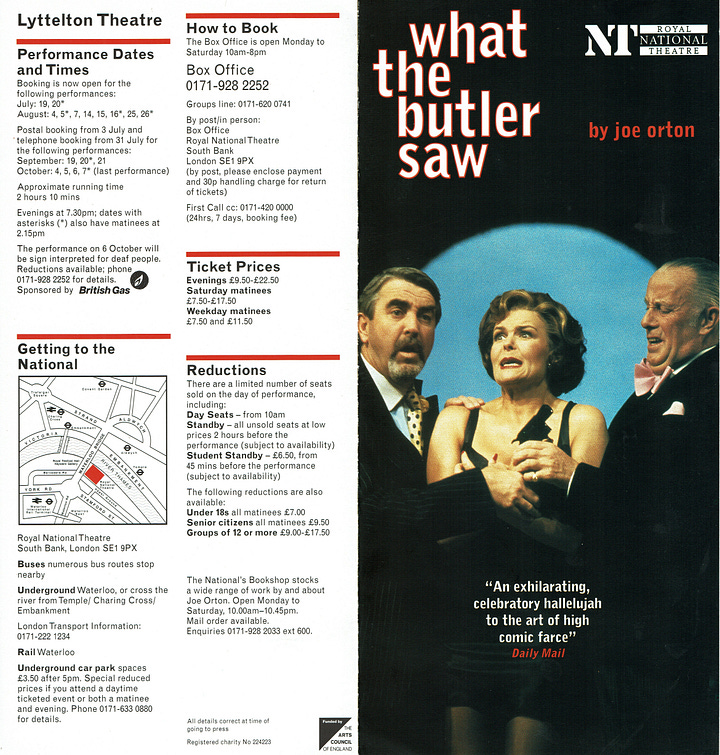Collecting David Tennant's Theatre Programmes: "What The Butler Saw" (1995)
...we sort through the many variations of this production's programme

In a first here at A Tennantcy To Act, I’m going to be approaching one of David Tennant’s theatre productions from an entirely different angle: that of a collector. If, like me, you’re someone who’s taken an interest in David’s theatre work with an eye towards collecting ephemera (programmes, flyers, etc.), this article may pique your curiosity.
Today’s feature will focus on the programmes and flyers associated with one of the first jobs David got after he moved to London: the 1995 production of What The Butler Saw. A farce written by Joe Orton in 1967, What The Butler Saw was set in a psychiatrist’s sexually-charged private clinic. David took on the role of the scheming young bellboy Nicholas Beckett.
Though I’ll have to get a bit in-depth about the play in order for everyone to understand all the ins and outs of identification, I want to be clear: this isn’t going to be an official deep dive. There’s a lot to unpack about What The Butler Saw, and that’ll be for another day. Instead, I’ll be walking David Tennant theatre programme collectors (and other interested parties) through how to differentiate between the multitude of programmes printed during the play’s run.
We collectors are lucky - for most of David’s theatre work after he arrived in London, he didn’t do many productions which toured multiple venues. By and large he either stayed at one venue throughout an entire run, or made a single transfer of the same production from one venue to another. Programmes for productions like these generally have clear differences in their covers and construction, and are fairly straightforward.
On a rare occasion David made two transfers of the same production, resulting in performances at three venues. You’ll see these associated with his years with the Royal Shakespeare Company, when they played “seasons” in Stratford, Newcastle, and London (an example is his trio of plays The Comedy Of Errors, The Rivals, and Romeo and Juliet in 2000). The programmes for these kinds of productions also have notable cover and internal differences, both large and small.
But What The Butler Saw is an outlier.
Notice I said it had a “multitude” of programmes? It does, and that’s one of the reasons it’s presented some problems for collectors. It certainly did for me for quite some time, as there wasn’t much context for me to draw from.
But just a few days ago, I discovered a lot more contemporary information about the play. This information helped shed some light on why the production’s programmes are like they are…and the remainder of my missing pieces finally started to come together. I was thrilled, so I thought I’d share my findings with the rest of the DT theatre collecting world.
—
We begin by conducting an examination of the covers of the What The Butler Saw programmes for its five venues: its debut at the National Theatre Lyttelton in London, and the four other venues the show moved to on a regional tour after wrapping up its dates at the NT: the Theatre Royal Bath, the Blackpool Grand Theatre, the Theatre Royal Norwich, and the Theatre Royal Nottingham.
There are a couple of noticeable differences about the covers of the six programmes available for this production. Obviously the venue names on the front of the programmes vary, but there are other differences, too. The programmes are different sizes. Five out of the six have white covers, and the last has a black cover. One has rehearsal photos of the cast while all the others have production photos of the cast. There are some minor design differences in the typography of the red letters. Some list Nicola Pagett in the role of Mrs. Prentice, and others list Isla Blair.
How can we make sense of this?
In the following image, I actually own only the first two and the last two programmes. The image for the third programme (Blackpool Grand) came from a friend of mine, and the image for the fourth venue (Norwich Theatre Royal) came from a flyer I saw in an Ebay auction, as I’ve never seen a Norwich programme:
In closeup, here are the theatre venue marks for each:
If you want to start collecting programmes from What The Butler Saw, you’re in luck. On the whole, programmes for the production are fairly easy to obtain - at least the ones for its run at the National Theatre (NT) Lyttelton. When you see one at auction, nine times out of ten you’ll find the black cover instead of any of the white ones. If you do happen to run across the white one, there’s a high chance it’ll also end up being from the National Theatre (NT) Lyttelton. This isn’t surprising; after all, the production’s regional tour was only a little over a month long, and it only ran five to seven performances at each venue.
Basically? The odds are not in your favor to find the regional varieties, so if you see one, grab it!
It’s at this point we need to address the elephant in the room - the only programme that looks nothing like the others. So let’s talk about the black cover variety of the National Theatre Lyttelton programme, and why it seems to be the easiest one to find.
The answer to that lies in the history of the production.
With previews from 24 February 1995, What The Butler Saw opened on 2 March 1995 at the National Theatre Lyttelton in London and ran until 12 April 1995. After its run there came to an end, the production moved to the four scheduled venues hosting its regional tour:
Theatre Royal Bath (25-29 April)
Blackpool Grand Theatre (2-6 May)
Theatre Royal Norwich (9-13 May)
Theatre Royal Nottingham (16-20 May)
I first compared the cast lists of all of these productions. Every program lists Nicola Pagett as a cast member in the role of Mrs. Prentice, except for the National Theatre (NT) Lyttelton program with the black cover.
I knew that cast change was important, but what it meant wasn’t exactly clear.
My first instinct was to postulate that the Lyttelton run from late February to mid-April had somehow been broken into two “eras”, so to speak - one with Pagett, the other with Blair. My running theory had always been that Pagett had started the run but - perhaps due to illness? - had to leave, and Blair had stepped in until Pagett could return. To my mind, this was a reasonable explanation for the two very different programmes: one white, one black. The fact all the other programmes which followed returned to the white cover and listed Pagett as a cast member only served to strengthen the likelihood of this theory.
That I didn’t test the validity of this theory (especially after obtaining a few flyers for the production with later acquisitions) is entirely on me. By the time I came by those flyers I’d shifted my research focus onto David’s very early Scottish theatre, and that part of his career quickly took precedence.
What The Butler Saw came back into focus for me because of recent interactions with an acquaintance on Bluesky: the lovely Lara (@lara102.bsky.social). She’s just beginning her journey collecting everything theatre-y involving DT, and helping her and watching her collection grow by leaps and bounds has been a joy. It’s also (happily!) triggered a few “wait a minute” moments for me, too, and that’s how I found myself digging though new sources of information in search of a resolution to the play’s plethora of programmes.
I started with the most obvious bone of contention: the confusion regarding Isla Blair and Nicola Pagett. I poured over reviews in newspapers and in the Theatre Record to see if I could find any mention of Pagett leaving the production during the Lyttelton run sometime between February and April of 1995. But there was nothing, which I found odd because I thought if it had happened it might be newsworthy. But nope. Every single review from that whole Lyttelton run mentioned Pagett in the role.
I was beginning to question my initial theory, though I supposed it was possible it was only a very short hiatus. But if so, wouldn’t that be a circumstance for an understudy? And why go to the trouble of printing another program? And lastly, if it was only a short replacement, why on earth is the black cover programme featuring Blair in the role the one which also happens to be the most easily obtainable programme of all?
I knew I was missing something, so after mulling it over a bit I expanded my search range to include all of 1995 and started to get some hits! Isla Blair finally began popping up in the role of Mrs. Prentice…but um, errrr, in August and September? But hadn’t the play closed in May?
As it turns out, no, it hadn’t. It did something I wasn’t expecting it to do.
After What The Butler Saw wrapped in Nottingham on 20 May 1995, the cast took a short break before heading back to London and the National Theatre Lyttelton Theatre. The play was about to go into rep (meaning, it became one of several different plays on a rotating schedule at the same venue).
It toured in rep from 25 May 1995 to 7 October 1995. Pagett’s term as Mrs. Prentice apparently ended sometime in June, and - ta da! - Isla Blair was her replacement during most of the rep dates!
Because it was in rep for so long, that’s why most of the programmes you see in the wild have black covers.


And what had prompted Pagett to leave What The Butler Saw after so many months in the role? Pagett’s 1997 memoir, Diamonds Behind My Eyes, revealed the reasons for her departure. Unbeknownst to Pagett, at the time she pursued and then accepted the role of Mrs. Prentice, she was suffering from undiagnosed and untreated bipolar disorder. The disorder flared during her time in the role, and by June, she had suffered a breakdown which required her hospitalization. Isla Blair was her replacement.
There was one thing I’d only tangentially noticed on the National Theatre Archive website about the performance tapes of What The Butler Saw that one can view by appointment: they have a performance recorded date of 5 October 1995.
If I’d given that discrepancy a couple more of my brain cells, I would’ve realized how much at odds that date was with my initial production end date of May 1995 and it would’ve triggered a further search.
But sometimes I can’t see the forest for the trees, either!
Anyway…learning that What The Butler Saw did over four months in rep made all the difference with regards to putting some order to the production’s programmes.
Taken generally, the programmes and flyers from the production’s run in rep from late May-Oct 1995 feature black covers, while its original and regional tour runs from Feb-May 1995 feature white covers.
But now that I’m sitting here typing this and thinking more about it, I feel I should learn my lesson and refrain from making that such a hard and fast rule - especially since I have some black cover flyers from the play’s rep season which feature both Pagett and Blair on the front!
You can see these below:


Studying these makes me wonder.
If flyers were printed ahead of the first month or so of What The Butler Saw’s rep season with Pagett on the cover before she had to pull out of the play…is it possible full programmes with this same image (the one above at left) exist and were printed at the same time and distributed along with flyers at shows?
If they do exist, I’ve never seen one in the wild. All the ones I’ve ever seen have the image above and at right on the cover (the one with Isla Blair). But if I’ve learned anything from all this What The Butler Saw programme madness, it’s not to assume you have all the information.
In conclusion, I hope I’ve helped all you David Tennant theatre collector buffs wondering about your What The Butler Saw programmes figure out what sorts you have, and what sorts you’re missing.
For now?
Don’t mind me. I’ll be planning how to beat all my newly-educated competition off with a stick if a What The Butler Saw black cover programme with Nicola Pagett on the cover ever does comes up for auction!










Can't wait for your deep dive into What the Butler Saw itself....I'm intrigued about that!